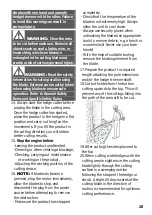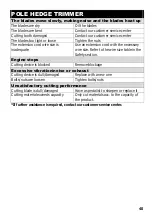
33
File all the left-hand cutters in one
direction first. Then move to the other
side of the saw chain and file all of the
right- hand cutters in the opposite
direction.
Occasionally remove filings with a wire
brush.
7) Use a depth gauge tool (not included)
to measure the depth gauge clearance
of each cutter. The depth gauge
clearance must be maintained at 1/32
inch (0.6 mm). The depth gauge
clearance determines the depth at
which the cutter enters the wood
during operation and the size of the
wood chips produced. Too much
clearance increases the chance of
kickback. Too little clearance decreases
the size of the wood chips, thus
deceasing the ability to cut.
Use a 0.025 inch (0.635 mm) depth
gauge jointer and a flat file (tools not
included) to lower the depth gauge to
the correct clearance.
After lowering the depth gauge, use
the flat file to restore the original
rounded shape to the depth gauge
Take care not to damage the cutting
edges or nearby links.
8) A height C larger than 0.6mm will
cause the chain to bite the wood and
will require a higher work rate from
the engine and a lower height will
mean that the chain will cut badly.
9) Verify the length of the cutting teeth.
All teeth must have the same length. If
necessary file the teeth until all of
them have the same length.
10)Sharpen each tooth equally by using
the same number of strokes.
11)Keep all cutter lengths equal. Check
the safety depth gauge height every 5
sharpenings. If the depth gauges are
also trimmed it is essential that the
original profile be restored.
12) Depth gauge measuring jigs are
available from most reputable tool
merchants.








































